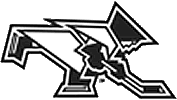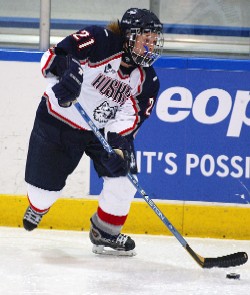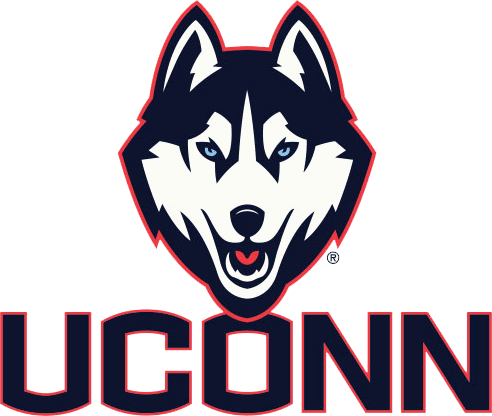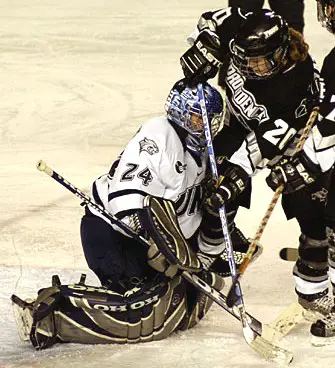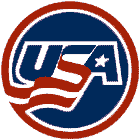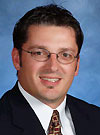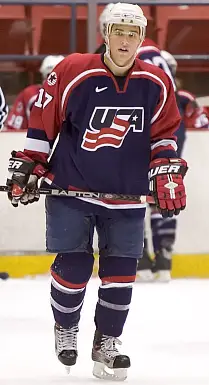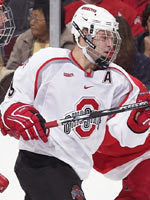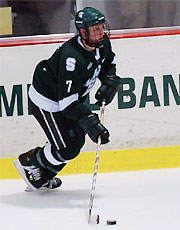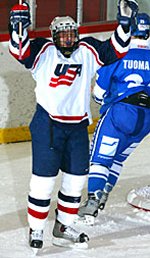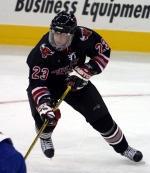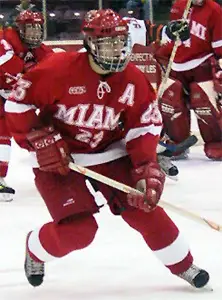From The Home Office In Wakefield, Massachusetts…
Welcome back, my friends.
This marks USCHO’s 10-year anniversary as it does mine writing here about Hockey East. For long-time readers and newbies alike, thanks for your attention.
It’s been interesting to see this space evolve from previews of the weekend’s games to the current column format. The previews were okay, but at the end of the weekend their usefulness was over and done with. Also, by the time the season was halfway done, it became increasingly difficult for coaches to say something about the upcoming games that hadn’t been said many times already. I mean, how many different ways can the theme “goaltending and special teams” be recycled?
So this space became a column and, with that change, came a multitude of possibilities. One of which, the top 10 list, I don’t believe I’ve ever used.
But what better time than a 10-year anniversary for a top 10 list?
Here then are the top 10 reasons why this will be a terrific year to be a Hockey East fan.
May I have a drumroll please…
Reason Number 10: The season got off to a great start with the dedication of the Jack Parker Rink at Boston University.
This can be a harsh business for coaches who, for reasons sometimes out of their control, don’t produce the requisite win-loss ratios. So it’s especially gratifying to see something special happen at the other end of the spectrum.
And the naming of the Jack Parker Rink at BU and its recent dedication are about as special as it gets.
Parker, whose 715 wins place him fourth on the all-time list and behind only Boston College coach Jerry York among active coaches, is a very special one. No only has he been extraordinarily successful, but he’s built a devoted following among Terrier alums by going the extra mile.
Perhaps the most telling moment at the dedication ceremonies came when assistant coach Mike Bavis said in a video following comments by Travis Roy, “We all have our difficult times in life. When people at BU do, Coach is there.”
Bavis knows whereof he speaks. His twin brother, Mark, was aboard one of the planes flown into the World Trade Center on September 11th.
Opposing fans may hate Parker’s guts because he’s synonymous with one of their top rivals and he’s been so irritatingly successful.
But even if he walks out of your arena with a win, making you grit your teeth with frustration, you still have to admire the coach and the man.
The phrase “The Jack Parker Arena” is a great honor and one richly deserved.
Number 9: The regular season should end with a bang.
Admittedly, it’s tough to top the last two years when the final weekend included New Hampshire playing a home-and-home with Boston University while Boston College tangled with Maine.
But this season’s regular season finale is none too shabby. The likely marquee series will be New Hampshire and Boston College, the two favorites in both the coaches’ preseason poll and USCHO’s Season Preview.
The other matchup that could catch loads of attention will be Massachusetts-Lowell and Vermont. Neither program is yet in the ranks of the perennial powerhouses; for now, that designation rests only with BU, BC, Maine and UNH. But both programs bear watching. The River Hawks could seriously challenge the likes of UNH and BC for the title. And as for Vermont, more on the Catamounts later. (With a skilled writer, that’s called “foreshadowing,” but with a hack like me it’s called “spilling the beans.”)
Number 8: More offense thanks to the rules changes
Yes, the games that opened the season last year were about as exciting as watching paint dry. In many of them, the Zamboni needed only to resurface the path to the penalty box. Newspaper box scores that included penalties in addition to goals and assists stood a very good chance of wiping out entire rain forests.
But it worked.
Unencumbered by interference and obstruction, skilled players enjoyed more room to show off the dazzling moves that fans enjoy.
It took some time for teams to adjust, and the rules do frustrate some of the more cerebral players who over the years had refined the fine art of toeing the line of what is and is not a penalty, but the game is better for it.
Number 7: The hat trick of new coaches at Providence, Northeastern and Merrimack.
Who can predict how things will turn out at these three schools? Both the coaches and yours truly picked the trio to finish in the bottom three slots in Hockey East. But who knows?
It could be a short-term boost of energy as each player redoubles his efforts to make a good first impression.
On the other hand, it could be a train wreck as three teams on the lower end of the talent totem pole struggle with new systems and approaches.
It should be interesting.
Number 6: The Chase To Replace
Who will rise to the challenge?
That became the theme for Maine, BC and Lowell when all three programs took major broadsides late in the summer as a result of Jimmy Howard, Patrick Eaves and Ben Walter all turning pro early.
Doom-and-gloomers might have raised the white flag, but the coaches’ response might best be summed up in the words of UML coach Blaise MacDonald. “With every loss is another tremendous opportunity. We have a lot of very talented players who are poised for breakout types of seasons.”
While fans of those programs certainly would have preferred that their stars came back for another year, it still makes for good drama to see who will step to the fore.
The early returns give evidence of that. Howard, who broke records as a sophomore with a 1.19 goals against average and a .956 save percentage, will be sorely missed, but both of his replacements in the Maine nets have done well in their first game: Matt Lundin (1.00 GAA, .917 Sv%) and Ben Bishop (2.87, .919). Bishop earned Hockey East Rookie of the Week honors.
For Lowell, Mark Pandolfo was the first to fill the Ben Walter void, scoring three goals in the River Hawks’ two games. Hockey East named him Player of the Week.
BC has not yet played since its exhibition game was cancelled due to poor ice conditions.
So the drama unfolds for those three teams. It’s more of a white knuckle experience without the three stars back, but it sure won’t be boring.
Number 5: The UNH Offense.
How’d you like to be UNH coach Dick Umile or a Wildcat fan and be able to say that even though you lost the top two scorers in the league last year — Sean Collins and Preston Callander — you still have the top three returning threats. That would be Jacob Micflikier, Brett Hemingway and Daniel Winnik, all of whom broke the 40-point barrier last season as sophomores. Yeah, you read that correctly. No typo or brain cramp by yours truly. Not one of those three will be a senior.
Oh yeah, there’s also Brian Yandle on the blue line as well as on the point on the power play. Yandle led Hockey East defensemen in scoring last year, just in case you wondered.
And to make this bounty an embarrassment of riches, there are Josh Ciocco, Matt Fornataro and Mike Radja, all of whom hit the 20-point threshold as underclassmen. Fornataro and Radja performed the feat as freshmen despite the logjam of talent in front of them. It’s only logical that with more ice time, bigger scoring roles and opportunities on the power play they’re almost a lock to take their production to the next level.
Games at the Whittemore Center will be a blast this year. Other than for opposing defensemen and goaltenders, of course. The over-under on the tossing of the fish should be roughly the 7:13 mark of the first period.
With all due respect to Boston College, I can’t understand why UNH wasn’t a near-unanimous choice to top Hockey East in the coaches’ preseason poll.
Number 4: The Vermont wild card.
How good is this team?
Hockey East snobs — and I’ll confess to having a bit of that nose in the air — will look at the Catamounts’ impressive record last year and say, “Let’s see you do it here in the big time. Then we’ll be impressed.”
Such snobs will have a point. There have been many ECACHL teams to respect in recent years. (So please hold the hate mail.) But there have been more elite Hockey East teams and the top-to-bottom depth has been considerably stronger. The interconference records have been testimony to that.
So UVM’s accomplishments can’t be dismissed, but they do carry an asterisk.
Still, I’m reminded of the Catamount teams a decade ago that featured Martin St. Louis and Eric Perrin and how in the NCAA tournament, no one gave them a chance. Until they saw them play.
Number 3: Great barns.
The arena situation within the league has only gotten better.
The Whittemore Center has been a personal favorite based on atmosphere, exciting teams to watch, press box sight lines and proximity to where I live. Many of the other arenas could point to strengths of their own, but the Whitt had it all.
Then along came The Jack Parker Rink at BU. Folks, if you haven’t been there, it’s an astonishing facility.
And a barn of a much different type that is new to Hockey East is Vermont’s Gutterson Field House. No one will confuse it with the edifice at BU, but it’s a charming, homey building filled with passionate fans. Add it to the list of excellent places to watch a game.
Number 2: More TV coverage than you can shake a stick at.
Without peeking ahead, guess how many Hockey East games will be on the tube this year? That includes satellite, cable and over the air stations.
No peeking! Have you no principles?
The answer is 70, a motherlode of coverage.
Of course, you need to get your lazy butt to some real live games, too, but when that isn’t possible, or if you just want to supplement your diet of college hockey with a few more helpings, then how good is having 70 telecasts?
And The Number 1 Reason Why This Will Be A Terrific Year To Be A Hockey East Fan: We’re Wickid Good
Check out the polls.
Six of the 10 league teams were in the preseason national rankings and a seventh received votes. That is, all but the new-coach trio of Providence, Northeastern and Merrimack entered the season on the national stage. The same holds true after the first week.
That bodes well for nonconference games in the early going and the NCAA tournament in the spring. The WCHA may once again be a tough nut to crack, but Hockey East appears to have many candidates to take their best shot.
All in all, there’s a smorgasbord of excitement ahead.
In Due Time
This year’s inaugural trivia contest will debut either next week or the week after. If this delay outrages you, feel free to vent in an email sent to [email protected].
And Finally, Not That It Has Anything To Do With Anything, But…
I need to tell you about the most consummate team player I know.
I lead a life that is crammed full to overflowing. There’s a day job that has become exceptionally challenging of late, writing for USCHO, teaching in the evening and then several other personal endeavors that consume considerable time. There are not enough hours in each day.
As a result, I frequently find myself in a squeeze. A deadline looms that I appear to have no chance of making.
The phrase “I am doomed” or words to that effect appear on my lips all too often. In such moments of distress, my wife Brenda unfailingly asks what she can do to help.
I often joke that I’ve been married for 29 years … five of the best years of my life.
But she’s a saint not only for putting up with my attempts at humor, but also for riding to the rescue when the pressure hits.
The latest example came when I was so far behind any reasonable milestones for writing the season preview that it bordered on the absurd. Unwilling to let go prematurely of some other endeavors I considered of great import, I had painted myself into the corner yet again.
Brenda, of course, came to the rescue.
She performed the most mundane of all tasks, transcribing interviews. We are talking hours of work here and work of the most boring variety. She willingly did it to bail me out.
That, my friends, is a consummate team player.
There were, of course, moments of unintentional comedy based on her unfamiliarity with the players.
Gionta was transcribed as “Jaunter” and Micflikier was just “M.” And there were just question marks for Van der Gulik.
Not to mention a transcription of a player as having “automatic point deduction” instead of “automatic point production.”
Good for a few laughs.
But heroic in bailing me out for the umpteenth time. For which a big thank you is due.
Of course, given the team player that I am, I’ll finish with one more point.
If you loved the season preview, thank you. I appreciate the compliment.
If you hated the season preview, then blame Brenda. I wouldn’t have finished it without her.

